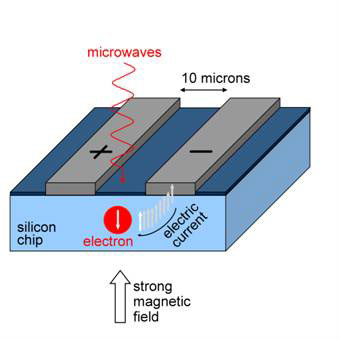| Posted: November 13, 2008 |
Scientists found a way to extend the quantum lifetime of electrons by more than 5,000 per cent |
|
(Nanowerk News) Physicists in the USA and at the London Centre for Nanotechnology have found a way to extend the quantum lifetime of electrons by more than 5,000 per cent, as reported in this week’s Physical Review Letters. Electrons exhibit a property called ‘spin’ and work like tiny magnets which can point up, down or a quantum superposition of both. The state of the spin can be used to store information and so by extending their life the research provides a significant step towards building a usable quantum computer.
|
|
“Silicon has dominated the computing industry for decades,” says Dr Gavin Morley, lead author of the paper. “The most sensitive way to see the quantum behaviour of electrons held in silicon chips uses electrical currents. Unfortunately, the problem has always been that these currents damage the quantum features under study, degrading their usefulness.”
|
|
Marshall Stoneham, Professor of Physics at UCL (University College London), commented: “Getting the answer from a quantum computation isn't easy. This new work takes us closer to solving the problem by showing how we might read out the state of electron spins in a silicon-based quantum computer.”
|
 |
| Microwaves are used to control the spin state of electrons held in silicon. This spin state can be watched in real time by measuring the electric current flowing between the (grey) electrodes.
|
|
To achieve the record quantum lifetime the team used a magnetic field twenty-five times stronger than those used in previous experiments. This powerful field also provided an additional advantage in the quest for practical quantum computing: it put the electron spins into a convenient starting state by aligning them all in one direction.
|
|
About the London Centre for Nanotechnology
|
|
The London Centre for Nanotechnology is an interdisciplinary joint enterprise between University College London and Imperial College London. In bringing together world-class infrastructure and leading nanotechnology research activities, the Centre aims to attain the critical mass to compete with the best facilities abroad. Research programmes are aligned to three key areas, namely Planet Care, Healthcare and Information Technology and bridge together biomedical, physical and engineering sciences. Website: www.london-nano.com
|
|
About UCL (University College London)
|
|
Founded in 1826, UCL was the first English university established after Oxford and Cambridge, the first to admit students regardless of race, class, religion or gender, and the first to provide systematic teaching of law, architecture and medicine. In the government's most recent Research Assessment Exercise, 59 UCL departments achieved top ratings of 5* and 5, indicating research quality of international excellence. UCL is in the top ten world universities in the 2007 THES-QS World University Rankings, and the fourth-ranked UK university in the 2007 league table of the top 500 world universities produced by the Shanghai Jiao Tong University. UCL alumni include Marie Stopes, Jonathan Dimbleby, Lord Woolf, Alexander Graham Bell, and members of the band Coldplay. Website: www.ucl.ac.uk
|
|
About the National High Magnetic Field Laboratory, Tallahassee Florida
|
|
The National High Magnetic Field Laboratory develops and operates state-of-the-art, high-magnetic-field facilities that faculty and visiting scientists and engineers use for research. The laboratory is sponsored by the National Science Foundation and the state of Florida. To learn more visit www.magnet.fsu.edu.
|

